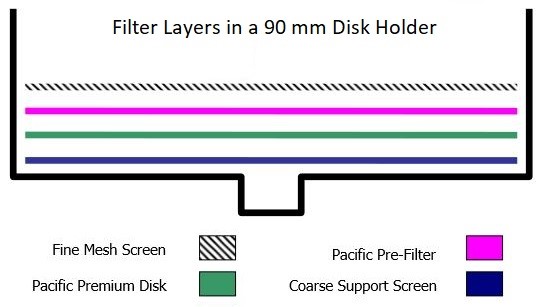Solid phase extraction is a powerful technique – it can be used to clean up the most challenging samples, and extract and preconcentrate hundreds of semivolatile organic compounds.
When performing the extraction, the goal is to get the entire sample to run through the extraction disk. But in order to do that, the disk must have the chemical and physical capacity to handle your sample matrix. If your disk becomes overwhelmed or clogs, you risk losing your sample and the chance to complete your extraction.
How do you prevent the disk from clogging? Prefilters!
When preparing your disk holder for an extraction, it’s vital to understand your sample matrix as much as possible. Believe it or not, you can usually investigate this just by looking at your sample. If you invert it and look through the wall of the bottle, what do you observe? Does the sample contain particulates? If so, are they large or small? Are there obvious particles such as pebbles, leaves or sticks? Do the particles settle quickly or do they tend to remain suspended in the matrix?
If your sample seems oily or soapy, you could be at risk for forming an emulsion during extraction. Emulsions aren’t addressed in this post, but they can be challenging to overcome and shouldn’t be ignored. Check out this recent blog post on extracting hexane-extractable materials from olive brines for navigating an extraction for oily samples.
The key to successfully extracting challenging samples is to use multiple types of prefilters. These will work together to separate the sample matrix into a lot of smaller layers reducing the possibility that any single filter gets overwhelmed and clogs. Here’s an approach I find useful:
- Make sure you’re using a large sized (90 mm) disk holder. This will give you a greater surface area for exposure to your sample, allowing a larger amount of suspended solids to be processed before the flow rate begins to slow and the disk begins to clog
- For samples that look dirty but don’t seem to have extremely high levels of particulates, use a layered prefilter approach. If you use 2 prefilters, stacked one on top of the other and each with a small pore size (~5 µm), you can significantly increase the amount of solids that are filtered from a sample before it reaches the SPE disk. Use caution when trying to stack more than 2 prefilters, as the effect of each filter seems to diminish quite a bit once you’ve stacked more than 2 together
- For samples that are very dirty and contain significant levels of particulates, particles, leaves, sticks or pebbles, add a fine mesh screen to your filter stack. These screens have much larger pore sizes and are great for filtering out large particles without clogging. This lets only the finer sediments and small particles to pass through to the prefilters which reduces the likelihood that they will clog. If you choose to use prefilters and a fine mesh screen, your fully loaded disk holder might look something like this:

- If you want to add filtering capability and 2 prefilters aren’t enough, you can add glass wool in between the fine mesh screen and the prefilter (or prefilters, if you’re using more than 1). It’s easy enough to use, but make sure you pull it apart and separate it into a loose layer, rather than a tight clump.
This layered filter approach comes in handy with samples like wastewaters. The more you can filter your sample prior to extraction, the cleaner and more successful your extraction will be. This application note for processing wastewater samples for oil and grease is a nice example of that.
If you’ve attempted all of the steps mentioned above and are still having trouble processing your samples, you might consider splitting your sample into smaller aliquots and processing them in smaller volumes. This is not a common approach to sample preparation and creates several opportunities for contamination, error or sample loss, so make sure your QC department and auditor are in agreement with you before you attempt this approach.

 Organic Workflow
Organic Workflow Peptide Workflow
Peptide Workflow Scale-Up Flash Purification
Scale-Up Flash Purification  Sample Preparation
Sample Preparation Biomolecule Purification
Biomolecule Purification Oligo synthesis
Oligo synthesis Scavengers and Reagents
Scavengers and Reagents Service & Support
Service & Support Accessories & Spare parts
Accessories & Spare parts Investors
Investors Reports & News
Reports & News The Share
The Share Corporate Governance
Corporate Governance Calendar
Calendar Sustainability
Sustainability Our Offering
Our Offering Our History
Our History Our Locations
Our Locations Leadership
Leadership